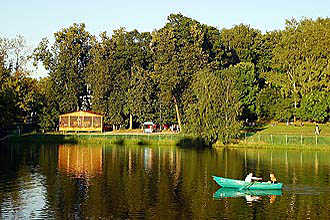|
 Located in the south-east of Moscow, right next to the Ring Road, this once glorious nobleman's estate has certainly seen better days. However, there's still a certain desolate romance to the ruins and half ruins in the grounds, and the park also plays host to some interesting events on occasion.
Located in the south-east of Moscow, right next to the Ring Road, this once glorious nobleman's estate has certainly seen better days. However, there's still a certain desolate romance to the ruins and half ruins in the grounds, and the park also plays host to some interesting events on occasion.
From 1820 to 1917 this suburban Moscow estate was owned by the Princes Golitsyn. The estate was laid out at the end of the 18th and the beginning of the 19th century, with various beautiful neoclassical buildings and a landscaped park.
The current Kuzminka Park occupies some 375 hectares, most of which is taken up by the estate. Some of the most important architects of the day were involved in the laying-out of the park, which is still a popular relaxation spot for Muscovites and visitors to the city, who enjoy its natural beauty as well as the various entertainments it offers.
The palace burned down in 1916, and only one wing survived. Next door is the Egyptian House (also known as the Egyptian Pavilion), designed by A.N. Voronikhina to reflect the influence of the monumental architecture of ancient Egypt - although it doesn't deviate much from the dominant Neoclassicism of the rest of the park. The Bath-House, gates, and iron fence with its lions also survived. Originally the Kuzminskaya estate had a large number of objects made out of iron, which were forged in a factory which also belonged to the Golitsyns.
The estate's Triumphal Gates are an exact copy of the iron palace gates at Pavlovsk, just outside St. Petersburg, as designed by Carlo Rossi. One of the park's finest features is the beautifully preserved Stable Yard with a pavilion decorated with sculptures of horses by Pyotr Klodt - again copies of the same architect's famous horses which adorn the Anichkov Bridge in St. Petersburg. In the center of the yard is a sculpture of Apollo and the muses.
Also of interest is the wooden Musical Pavilion, built by Domenico Giliardi to create as perfect an acoustic as possible so sound would carry throughout the park.
The park has also preserved two stone caves and two bridges from the 18th and early 19th centuries, as well as the Church of the Vlakhernskaya Icon of the Mother of God. The Church was built between 1759 and 1774, with funding from Prince M.M. Golitsyn. It was originally planned in baroque style, but ended up being classical. The church was reconsecrated in 1992.
Not far from the church is an annex of the Museum of the History of Moscow, opened for the capital's 850th anniversary.
Getting there: The main entrance to Kuzminsky Park is a 10-minute walk from Kuzminka Metro Station. The best way to get to the estate gates is by bus no. 29 or B from Ryazansky Prospekt Metro; it's about a 10-minute ride.
Opening hours for the Egyptian Pavilion: Daily from 11:00 to 17:00, closed on Tuesdays.
|

 Located in the south-east of Moscow, right next to the Ring Road, this once glorious nobleman's estate has certainly seen better days. However, there's still a certain desolate romance to the ruins and half ruins in the grounds, and the park also plays host to some interesting events on occasion.
Located in the south-east of Moscow, right next to the Ring Road, this once glorious nobleman's estate has certainly seen better days. However, there's still a certain desolate romance to the ruins and half ruins in the grounds, and the park also plays host to some interesting events on occasion.